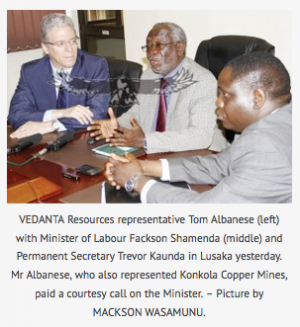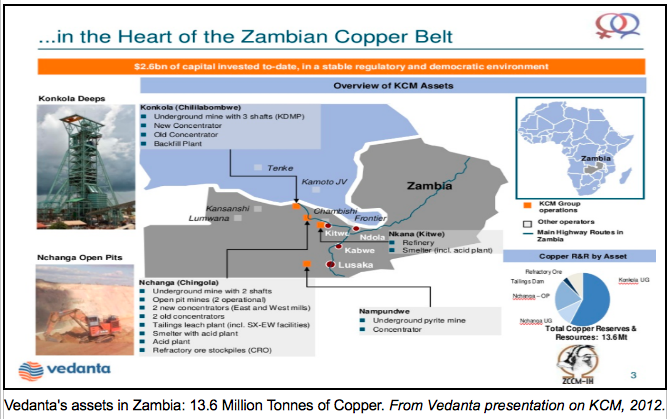Last week several articles were published in the Zambian media reporting on a press briefing held by Vedanta executive Tom Albanese following a ‘closed door meeting’ he held with Labour and Social Security Minister Fackson Shamenda in Lusaka, Zambia, on the 7th February. Mr Albanese met with the Minister to refute claims made in Foil Vedanta‘s report ‘Copper Colonialism: Vedanta-KCM and the copper loot of Zambia‘, released to the Zambian press on January 31st. The report demonstrated that, contrary to their claims, Vedanta’s subsidiary Konkola Copper Mines (KCM) are making considerable profit in Zambia and are guilty of casualising the labour force as well as causing severe environmental damage.
We want to respond to some of the claims made by Mr Albanese, and present more evidence of Vedanta’s campaign of misinformation here.
Please click this link to download the full report: Copper Colonialism: British Miner Vedanta KCM and the copper loot of Zambia
or read it online at this link.
Our response also has been printed in the Lusaka Times and national level debate around the report is documented in the Zambia Post newspaper.
An article published on the 7th February in the Zambian Daily Mail states that:
..Mr Albanese said the profit and loss accounts of KCM are transparent. He said audit reports which are thoroughly scrutinised are made available within the country and outside.
“On behalf of the shareholders and subsidiaries of Vedanta, the reports are prepared according to Zambia, United Kingdom and United States (US) financial regulations,” Mr Albanese said.
He said despite KCM making profit, most of it is lost to taxes and operational costs.
“I can assure you I have a responsibility to ensure that those reports are transparent. I will be happy to have face-to-face discussions with any NGOs that feel the company is externalising its profits,” Mr Albanese said.
He disclosed that Vedanta has over the past nine years invested over US$2.3 billion into Zambian economy through KCM.
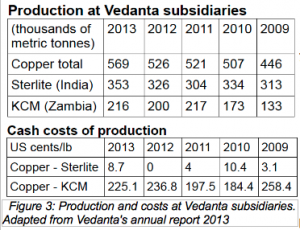 It is very hard to find out exactly how much profit Vedanta is making from KCM as KCM’s annual reports are not made public in Zambia or elsewhere, contrary to Mr Albanese’s claims of transparency. Lacking this figure, our report uses figures from Vedanta’s 2013 annual report to calculate profit. Page 187 of the report clearly states that production costs at KCM were 255.1 cents/lb in 2013, while 216,000 tonnes of copper were mined. At a copper price of $7,300 (the average during 2013) this would constitute a profit of $362 million (tonnes of copper produced x value of copper per tonne – cost of production). We also reported that financial analysts from Global Data suggested that KCM made 12.19% of revenue for the entire Vedanta group (18 subsidiaries) in 2012.1
It is very hard to find out exactly how much profit Vedanta is making from KCM as KCM’s annual reports are not made public in Zambia or elsewhere, contrary to Mr Albanese’s claims of transparency. Lacking this figure, our report uses figures from Vedanta’s 2013 annual report to calculate profit. Page 187 of the report clearly states that production costs at KCM were 255.1 cents/lb in 2013, while 216,000 tonnes of copper were mined. At a copper price of $7,300 (the average during 2013) this would constitute a profit of $362 million (tonnes of copper produced x value of copper per tonne – cost of production). We also reported that financial analysts from Global Data suggested that KCM made 12.19% of revenue for the entire Vedanta group (18 subsidiaries) in 2012.1
If the production costs and volumes recorded in Vedanta’s own annual reports are incorrect we would welcome Vedanta to amend them and make KCM’s annual reports available to the public.
We do not know how much Vedanta paid in tax in 2013, but it is unlikely to add up to $362 million. In our report we noted Vedanta’s 2007 brag to investors in a presentation that PAYE (Pay As You Earn) deductions from worker’s wages made up nearly 50% of their tax contributions to the Zambian Government2, and that their 2013 Annual Report states that they have ‘US$1,263.4 million of unutilised tax losses’ at KCM which will minimise tax payments and ‘generate economic benefits for the company‘.3 These two claims suggest that tax and royalty payments are fairly minimal.

We would welcome Vedanta and the Zambian government to reveal the actual tax payments from Vedanta-KCM to the Zambian exchequer over recent years.
Secondly, Vedanta often repeat the mantra that they have invested $2.3 billion in KCM. This ‘investment’ is not a charitable gift to the Zambian state, but capital input to help them increase their profit from mining and processing activities, such as the new Nchanga smelter and the Konkola Deep Mining Project. It is not the Zambian state who will gain from these ‘investments’ but Vedanta itself, through increased profits and production. In fact the Development Agreements Vedanta signed with the government in 2004 allow them to deduct 100% of capital allowance from any investments made – such as prospecting, buildings and equipment, so these ‘investments’ benefit the company twice – through increased production and tax breaks. Vedanta’s secret Development Agreement for KCM can be read at the website of Mine Watch Zambia, to whom they were leaked a few years ago.
On 6th February the Lusaka Times also reported that following the closed door meeting between Tom Albanese and Labour and Social Security Minister Fackson Shamenda, ‘Government and Vedanta Resources Plc have amicably resolved all differences surrounding the retention of workers at the mining giant’, and agreed ‘on the need to reduce the number of workers being employed as casual employees as well as engaging them on contractual basis.’
It is wonderful for KCM employees to know that the planned 2000 redundancies may not go ahead, and that the 11,000 strong (out of 18,000 total) casual labour force may be given contracts and security. However, there is an irony in this announcement coming from Tom Albanese, the six year CEO of Rio Tinto, who retired in 2013 and became Chair of one of Vedanta’s investment holdings subsidiaries Vedanta Resources Holdings Ltd (NOT Chair of Vedanta Resources as the two articles claimed). From 2007 until 2013 Albanese presided over a number of major workers rights violations at Rio Tinto, a global mining company famed for their ‘company wide de-unionisation policy‘. Tom Albanese was famed for being one of the highest paid CEOs on the FTSE 100, earning £11.6 million in 2011.
Just a few days ago 200 people marched against Rio Tinto’s ill treatment of mineworkers outside the international conference, Mining Indaba, in Cape Town. News reports claimed ‘a labour movement that represents workers in some 142 countries claims Rio Tinto is one of the most aggressive anti-union companies in the sector.”
Rio Tinto as well as Vedanta have been removed from the Norwegian Government Pension Fund’s Global Investments for ‘severe environmental damages’ and unethical behaviour following investigations. The Norwegian government divested its shares in Rio Tinto in 2008, while it divested from Vedanta Resources in 2007, and also excluded Vedanta’s new major subsidiary Sesa Sterlite from its portfolio just a few weeks ago in January 2014.
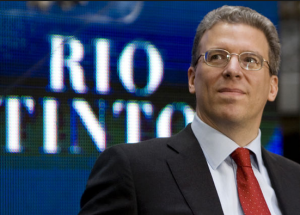 It is alarming that Tom Albanese would be praised for his promise of workers rights and security by the Zambian papers without a mention of his history of presiding over well documented human rights abuses. The Zambian authorities should keep a close eye on workers’ rights standards at KCM to ensure recent promises are enforced. The Lusaka Times article quotes Labour Minister Mr Shamenda’s statement that:
It is alarming that Tom Albanese would be praised for his promise of workers rights and security by the Zambian papers without a mention of his history of presiding over well documented human rights abuses. The Zambian authorities should keep a close eye on workers’ rights standards at KCM to ensure recent promises are enforced. The Lusaka Times article quotes Labour Minister Mr Shamenda’s statement that:
“With new management at Vedanta and PF [Patriotic Front] being new in power, we have agreed to bring on table the new approach to business to have a win, win situation as we bury all our past differences and looking forward to cordial working relations.“
Who are the new management at Vedanta Resources? The management structure has not changed recently, and Anil Agarwal remains the Chairman and 68% owner of Vedanta (as of 7th February). Has Tom Albanese misled the Zambian media that he is in fact the Chairman of the company (rather than the Chairman of a little known investment holding subsidiary), or is this an error in printing?
Finally, our press release on our recent report highlighted the fact that Vedanta have created misconceptions in Zambia, such as the predominant idea that they are an Indian company when they are in fact British. We want to highlight the importance of this distinction here.
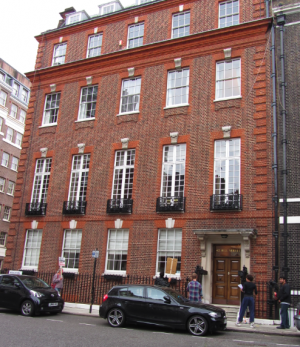
Vedanta are registered and domiciled in Britain, where majority owner and Chairman Anil Agarwal is also a resident and lives in a £20 million mansion in Mayfair, London. It is the British authorities which regulate Vedanta, and British tax laws and ethical standards which they must abide by. The London registration is important to Vedanta for attracting investment, and because it allows them unrestricted use of the UK’s many tax haven territories, such as the Bahamas islands – where Anil Agarwal keeps the enormous profits from his 68% share in Vedanta, via his holding company Volcan Investments, avoiding paying any tax in the UK or elsewhere. Vedanta’s British registration is also important because any grievances with Vedanta in Zambia should be taken to the British, not Indian, authorities.
For more information on Vedanta’s management of KCM in Zambia, including its undervalued sale to them in 2004, and their environmental and workers rights violations, as well as their pattern of abuses in other countries where they operate, and an analysis of the global interests controlling Zambia’s important copper resource, please read the full report ‘Copper Colonialism: Vedanta-KCM and the copper loot of Zambia‘ on our website.
Foil Vedanta is not an NGO, as media reports have claimed, but a grassroots international solidarity group linking communities affected by Vedanta and carrying out cutting edge research on the company and related issues.
Footnotes
